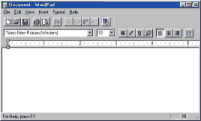
WordPad
Another word processor: WordPad
NotePad is quite simple, if you're looking for another word processor with more features look no further just click on WordPad Start>>Programs>>Accessories
 WordPad is
another word processor inside windows,
WordPad is
another word processor inside windows,more advanced that NotePad.
The WordPad window looks more eleguant than NotePad's, you have lots of features: Fonts, Colors, Pictures. WordPad has everything you will need to compose text. Of course you have more sofisticated programs like Word 97 and Word Perfect, still you can
do a lot with WordPad.
The most important commands like Save, Open, New, Print and Find are right under
your fingertips, just click on the icon without going through the menus.
You can even copy, cut/paste with a single click. WordPad has lots of icons,
this makes your job much easier. To get even faster use CTRL C, CTRL X, CTRL V.
With keyboard shortcuts you can perform tasks a lot faster.
Begin composing some text, try to use Font and Font size to write, just select a Font name and size from drop down menus.
Now you begin to see why WordPad is more efficient than NotePad.
You can write in Bold, Italic and Underline your text plus you can add colors.
Easily align your text to center, right, or left of page. Composing text is indeed professional with WordPad Use
A faster way to compose text is to do as in Notepad: write down everything without using any special features, when you're done you can add formatting to your text,
use titles and bold letters, colors, bullets, even pictures.
Use the ruler at the top to define the edges of your text, just move the ruler cursor
to define the width of your document.
WordPad let you also add date and time to your file with style, click on
select the Date and Time format you want to use.
Always be careful when using fonts, if you intend to open the document on another computer make sure the fonts you are using are installed on that computer.
The best thing to do in the case is try not to use fancy fonts. The most popular fonts are Verdana, Courier, Arial, Times New Roman.
If you're running an Arabic version of Windows, you can write Arabic and English inside WordPad very easily, just choose an arabic font and start writing in arabic, you can combine english and arabic in the same document.
A useful feature for Printing is Print Preview You can preview your files before printing
go to File>>Print Preview
Don't forget to save your file regularly.
When you click New you can select between 3 text formats
Word Document, Rich text Document, and Text Document.
Both Word Document and Rich text Document allow you to add rich content like images and colors to your text file, Text document is only text.
Text files can have .txt .doc .rtf extensions
From File menu you can switch from one document to another using the Recent file listing without even closing the window
WorPad contains all the features in NotePad plus new ones to enhance the writing experience. You can easily find text in WorPad and also replace a word by another, suppose you have the word "bike" in your text and wanted to replace it by "moto",
it would be painful to search all the document and replace each occurence manually.
click Edit>>Replace or CTRL H type the word you want to find near Find What and type
the word you want to replace with near Replace With. You can also match the word case: replace Bike only and not bike.
Another new feature is Paste Special, this special Paste command allows you to paste anything with its properties. Suppose you want to copy some text from a foreign text application and paste it as is, use Paste Special.
You will begin to understand the uses of this command as you learn more.
If you've already drawn an image, you can add it to your file click Insert>>Object... choose Bitmap image use Create New to open Paint inside NotePad and start drawing without leaving WordPad, press Esc to return.
Create from File let you insert an image from the hard drive, press Browse to specify the location of the image type c:\windows\*.bmp and choose any file.
Control the Format of your documents and specify which font to use at Format>>Font
You can also set Paragraph identation and alignment, document width with Tab Stops.
View>>Options let you specify settings like Wrapping long lines to window or ruler.
Wrap to ruler to set an end of line. You can also change measurement units. (cm, inch)
Wrapping also applies to inserted objects: under Options select Embedded tab, choose
Wrap images to ruler or window.
Once you've inserted an image just right-click and select Object Properties to get its properties e.g size.
You can edit/modify the image using Bitmap Image Object: select Edit to modify the image from within WordPad without opening Paint, press Esc to return to normal window.
To launch Paint and edit the image, select Open.
Later, you will learn how to link an image to other applications: Yes ! from WordPad
you can launch another application by clicking on an image. It's like creating your own desktop. We will also explain what are Linked and Embedded objects
To master the features in WordPad you should experiment with all menus, try to type few documents using bold letters and Paragraph identation
Indentation: means that your paragraph begins a certain position away from margin.
The ruler is quite useful and indicates idicates actual measurements.
From View>>Options, click Options tab, choose a unit then press Ok.
Press F1 or go to Help menu to access the application's Help file.
UNDO also works in WordPad and will only cancel the last action.
Use View menu to hide/show the toolbar, the ruler and other tools...
Remember that the best way to learn is to practice